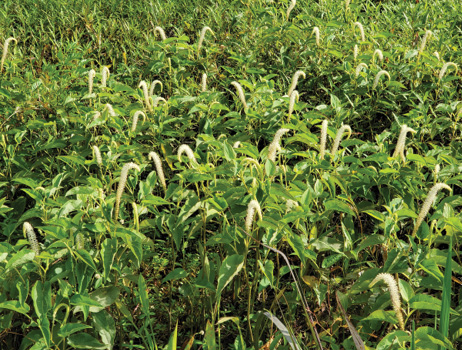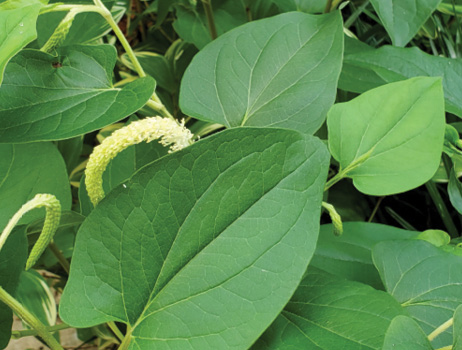Lizard’s Tail | Saururus cernuus
Emergent | Native



Lizard’s tail is an attractive native species with an erect growth form that reaches 1–2 feet in height.
Leaves are rich green and typically shaped like stretched hearts or arrowheads. They are sharply pointed with obvious palmate veins radiating out from where the stalk joins. Usually there are five primary veins that divide into smaller branches much like a tree. Leaves are typically 4 inches long and 2 inches wide.
The flower spike is a showy spire of many small, crowded, white flowers that resembles a bottle brush. It is usually 4–8 inches in length and extends higher than the leaves.
Lizard’s tail is primarily a shoreline or shallow water plant, although it can grow in strictly terrestrial areas. It spreads via underground runners and can expand quickly once established.
Management Value
Lizard’s tail has little known wildlife food value. The foliage is toxic and avoided by mammals, but some insect species consume the roots. Despite the lack of wildlife food value, the species likely provides habitat to young fish and other species. It will typically stay on the shore or in shallow areas, and although it can spread rather quickly, it can be easily controlled.
Lizard’s tail alone rarely causes significant management issues, and it is a beautiful backdrop to many water bodies. Thus, this species can be used as an ornamental addition to ponds and water gardens, with periodic control of its spread as needed.
Recommended Controls
Glyphosate (5.4-pound formulation). For each gallon of water, mix 5.0 ounces glyphosate and 1.3 ounces non-ionic surfactant. Spray to wet all exposed plants. Do not exceed annual herbicide rate limits as stated on the product label.
Lizard’s tail is usually not in water more than a foot deep. If the majority of the plant is on the shoreline, it does not represent a significant threat of oxygen depletion and can be treated at one time.
The best approach is to treat ponds with herbicides when water temperature is at least 60˚F, and the plants are actively growing. Multiple applications are likely necessary to achieve eradication.
Read and follow all chemical label instructions, especially the section on the use of personal protection equipment.

The information given here is for educational purposes only. References to commercial products, trade names, or suppliers are made with the understanding that no endorsement is implied and that no discrimination against other products or suppliers is intended.
Publication 3735-28 (POD-11-23)
By Wes Neal, PhD, Extension/Research Professor, Wildlife, Fisheries, and Aquaculture; Dennis Riecke, Fisheries Coordinator, Mississippi Department of Wildlife, Fisheries, and Parks; and Gray Turnage, PhD, Assistant Research/Extension Professor, GeoSystems Research Institute.
The Mississippi State University Extension Service is working to ensure all web content is accessible to all users. If you need assistance accessing any of our content, please email the webteam or call 662-325-2262.



